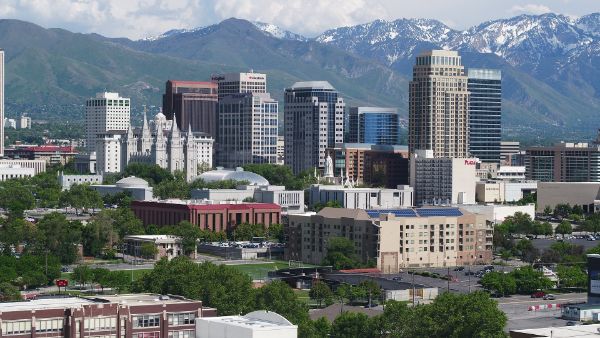Housing First: Utah Ends Homelessness And Provides Shelter For All
By Scoop.me / Philipp Stadler
In the USA, there are more than five times as many vacant homes as there are homeless people. The state of Utah has therefore implemented the “Housing First” program and started to provide shelter for all in need, meaning that homeless people in the state receive apartments without any preconditions. Thanks to the Housing First program, the number of chronically homeless people in Utah has been reduced by 91% in ten years. Crucially, the program is cheaper than accepting homelessness.
The United Nations estimate that about 100 million people worldwide are homeless. Around 4 million of them live in Europe, and 3.5 million US-citizens have no shelter. On the other hand, there are 18.9 million vacant homes in the USA. This means there are more than five times as many vacant apartments as there are homeless people. It is the same in Europe: more than 11 million homes lie empty across Europe while 4 million people have no roof over their heads.
How “Housing First” works
This is why the US state Utah launched the Housing First program in 2005. It reverses conventional homeless aid. Commonly, homeless people are expected to look for a job and free themselves from their psychological problems or addictions before they receive help in finding accommodation. The Housing First program reverses the path. Homeless people get a flat before anything else. They receive accommodation without any preconditions – on the basis that every citizen should have a residence. The idea is that with the guaranty of a home to live in, it is easier to find a job and take care of mental health problems.
Utah started with 17 homeless people
Utah started the Housing First program in its capital Salt Lake City. The state chose 17 of the most challenging cases of chronic homelessness who had spent an average of 25 years on the street and provided shelter for them. The apartments were not subject to any conditions, there were no restrictions or rules. The participants only received the offer to be supported by caseworkers. 22 months later, all 17 former homeless people were still housed, including Keta. She had lived on the streets for more than 20 years and had been an alcoholic.
Lloyd Pendleton, director of Utah´s Homeless Task Force, says that trust is crucial. He reports about Keta, one of the first participants of Housing First:
“The first night in her apartment, she put her belongings on the bed and slept at the floor. The next three nights she slept out by the dumpster near the apartment building. With the aid of her case manager, she moved back into her apartment, but continued to sleep on the floor for several nights. It took over two weeks for her to develop enough trust that this apartment was hers and will not be taking away from her.”
With confidence and a safe home, people find the strength to solve their problems. Today Keta is still sleeping in her own bed – and she is sober.
Utah reduced chronic homelessness by 91%
In addition to Keta, the Housing First program helped state-wide more than 2,000 other people out of homelessness. Within ten years, the number of chronically homeless people in Utah has been reduced by 91%. In the neighbouring state of Wyoming, on the other hand, homelessness rose by 213% over the same period.
The Housing First program also works in other countries. Finland has been implementing the Housing First concept since 2008 and is the only country in the European Union where the number of homeless people is declining. The Finnish NGO “Y-Foundation” buys flats on the private housing market and renovates existing apartments with one or two rooms. Then, they provide the flats to people in need. Social workers, who have offices in the residential buildings, help with financial issues such as applications for social benefits. 4 out of 5 former homeless people make their way back into a stable life through Finland’s Housing First program.
Housing First is cheaper than homelessness
The Housing First program is not only a method of helping the homeless: besides humanitarian reasons, there are also economic advantages. In Utah, the state has to spend an average of 16,670 dollars for each chronically homeless person per year. That includes costs for emergency services, legal expenses, or jail time. In contrast, the costs to house homeless people and provide case management services to them only makes up 11,000 dollars per person.



 Binoy Kampmark: Failed Machismo - Israel’s Pager Killings
Binoy Kampmark: Failed Machismo - Israel’s Pager Killings Ramzy Baroud: Israel’s True Objectives In Gaza, And Why It Will Fail
Ramzy Baroud: Israel’s True Objectives In Gaza, And Why It Will Fail Martin LeFevre - Meditations: How Deep Does The Human Crisis Go?
Martin LeFevre - Meditations: How Deep Does The Human Crisis Go? Gordon Campbell: On ACT’s Plans To Strip Away The Rights Of Gig Economy Workers
Gordon Campbell: On ACT’s Plans To Strip Away The Rights Of Gig Economy Workers Peter Dunne: Dunne's Weekly - Hipkins' Risky Overseas Trip
Peter Dunne: Dunne's Weekly - Hipkins' Risky Overseas Trip Binoy Kampmark: Peter Doherty - Public Science Communicator
Binoy Kampmark: Peter Doherty - Public Science Communicator